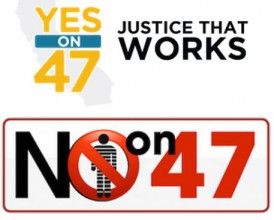Fight flares over ‘realignment,’ Prop. 47 effects on crime
by Chris Reed | March 25, 2016 9:02 am
 The battle over state policies that some call soft on crime and some see as humane and thoughtful appears to be flaring anew, with prominent law-enforcement officials on both sides.
The battle over state policies that some call soft on crime and some see as humane and thoughtful appears to be flaring anew, with prominent law-enforcement officials on both sides.
The first of the policies was Gov. Jerry Brown’s 2011 decision to “realign” the corrections system and shift 30,000 prisoners from state institutions to county jails. With many county facilities as overcrowded as state prisons, this led to an estimated release of 18,000 people who were incarcerated in California. The second was state voters’ 2014 approval of Proposition 47, which reclassified some drug and property crime offenses from felonies to misdemeanors, which also led to more convicted criminals avoiding getting locked up. It was strongly supported by the governor.
What’s been the effect? That is a crucial question, given that California’s violent crime rate jumped significantly in the first half of 2015. In California’s 68 cities with populations of 100,000 or more, violent crime increased by 11 percent, according to statistics compiled by the FBI.
This suggests that “realignment” and Prop. 47 might have a cumulative effect. A December 2013 report [1]by the Public Policy Institute of California downplayed any link between a smaller increase in violent crime in 2011 and 2012 and the effects of “realignment”:
We find that California’s crime rates increased between 2011 and 2012 — violent crime went up 3.4 percent and property crime went up 7.6 percent. These rates vary widely across the state, with California’s 10 largest counties generally seeing greater increases in crime than in the state overall. However, despite this pattern of increase, crime rates remain at historically low levels in California today.
How does realignment relate to the recent uptick in crime? Our analysis of violent crime finds no evidence that realignment has had an effect on the most serious offenses, murder and rape. The evidence on robbery is more uncertain, with a possible indication of a modest increase related to realignment. California’s overall increases in violent crime between 2011 and 2012 appear to be part of a broader upward trend also experienced in other states.
Did reducing felonies help ‘the crooks win’?
Now, 17 months after Proposition 47’s adoption, opinions are beginning to harden on its effects.
In November, Los Angeles County Sheriff Jim McDonnell depicted the initiative as a well-intentioned failure[2]. And on PoliceOne.com, a website on police issues, a December opinion piece[3] declared “the crooks won.”
Inmates are fans of Prop. 47 because it keeps them out of jail, allowing them to keep using illegal drugs and keep committing crime. Even if they miss their court date (which in turn gives them a warrant), inmates know the crimes and the misdemeanor warrants will not keep them locked up long. Inmates view misdemeanors as “not a big deal” and shrug their shoulders. It does not matter that there are hardworking citizens who are being victimized. Criminals usually never show remorse or empathy for their victims. Criminals have a great way of decriminalizing and minimizing their crimes. With Prop. 47, the state and the criminals both are doing just that.
But William Lansdowne, a veteran California police chief, strongly challenges this assessment in an op-ed[4] posted Thursday by the San Francisco Chronicle:
Since Prop. 47 passed, critics have tried to scapegoat it for a rise in crime, but there’s no evidence proving such an assertion. As the former police chief for San Diego, San Jose and Richmond, I know all too well that every shift in crime must be addressed. There is nothing more important than public safety. But in paying close attention, we need to be honest about the facts and avoid misleading the public.
‘The studies are not done and the results aren’t in’
Others suggest that both McDonnell and Lansdown are too quick to draw conclusions:
Keramet Reiter, a criminology professor at UC Irvine, said the ballot measure has been used by critics as a “convenient scapegoat” for the rise in crime. The reality, she said, is more complicated in a state that is undergoing broad changes to its criminal justice system, including a massive shift of inmates from state prisons to local jails.
The Los Angeles Police Department has reported a double-digit increase in property crime so far this year, but Chief Charlie Beck said it is premature to fault Proposition 47.
“The studies are not done and the results aren’t in,” Beck said.
That is from a November Los Angeles Times report[5].
The rise of Big Data has led to many changes in policing strategies in recent years, most notably in New York City, where the NYPD uses algorithms to predict[6] likely trouble spots. But big-think arguments over why crime has gone down sharply over the last 25 year have actually gotten more complex, not less. Last year, Vox detailed 16 different theories[7] explaining the phenomenon.
- report : http://www.ppic.org/content/pubs/report/R_1213MLR.pdf
- failure: http://www.latimes.com/opinion/la-ol-1104-prop-47-revolution-sheriff-jim-mcdonnell-20151104-htmlstory.html
- piece: https://www.policeone.com/drug-interdiction-narcotics/articles/57282006-What-we-learned-from-Californias-Prop-47-in-2015/
- op-ed: http://www.sfchronicle.com/opinion/openforum/article/Prop-47-is-not-raising-crime-rates-7044658.php
- report: http://www.latimes.com/local/crime/la-me-prop47-anniversary-20151106-story.html
- predict: http://citylimits.org/2015/01/29/why-nypds-predictive-policing-should-scare-you/
- 16 different theories: http://www.vox.com/2015/2/13/8032231/crime-drop
Source URL: https://calwatchdog.com/2016/03/25/fight-flares-realignment-prop-47-effects-crime/